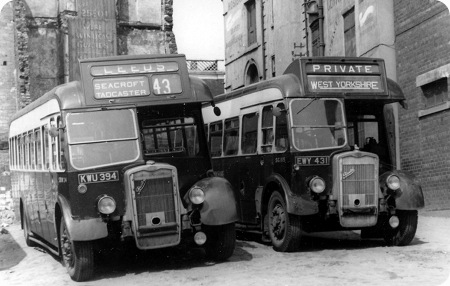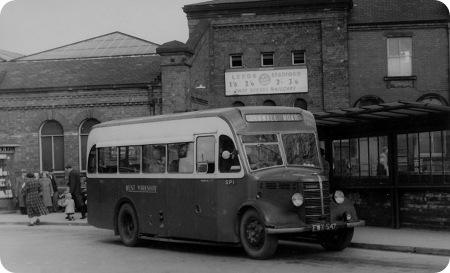
Photograph by ‘unknown’ if you took this photo please go to the copyright page.
West Yorkshire Road Car Company
1952
Bristol LWL6B
ECW B39R
Here we have a pair of Bristol Ls the one on the left is a 30ft long by 8ft wide version with a Bristol 8.1 litre 6 cylinder engine. The one on the right is a 1947 L5G registration EWY 431 fleet number SG115 this bus differs from the LWL6B by being a B35R 26ft long by 7ft 6in wide and having a Gardner 7.0 litre 5 cylinder engine. To say there is an age difference of 5 years between them there is not many changes body wise, but at that time just after the war all that was required were buses and as many of them as possible.
A full list of Bristol codes can be seen here.
A full list of West Yorkshire codes can be seen here.
———
The reason for the very minor changes in these bodies, other than size and capacity, throughout their production run is a simple and exemplary one. They were an absolutely superb design, and the quality of the construction and of all the fittings was the best. Personally I also believe that they were the finest looking single deckers of the "front engined" era and also they combined the high quality and good looks with superb passenger flow, visibility and luggage space. A particularly appealing variant was the 31 seat coach, many examples of which were mounted,in addition to the Bristol majority, on Leyland PS1 chassis which made for another different but most attractive combination.
Chris Youhill
———
SG 115 was always one of the regular Yeadon depot based (EWY registration) Bristol L5Gs used on my school special afternoon service from Otley Grammar School to Burley-in-Wharfedale in the mid to late fifties. I have very fond memories of these buses and particularly remember the lovely purring noise when at speed with the clunk of the gear stick into overdrive 5th or would this be 4th? WYRCC always exuded to me a feeling of what a "Tilling" Company should be. Happy days.
Richard Fieldhouse
———
I share your acoustic memories of these fine vehicles Richard, and I remember the very first "EWY" registrations immediately after the War. I was just stunned by their clean lines and attractive and very functional interiors. As with all other Bristol Ls and Ks so fitted the fifth gear (nickname "supertop") was actually an external overdrive in addition to the normal four speed box – this accounts for the glorious melodious tones when engaged. It was engaged from fourth gear (NOT through neutral) by moving the lever to the right and smartly forward. It was virtually essential to adjust the engine revs and to return to the main gearbox fourth position well before the bus stopped or you might well be "stuck" in overdrive. I am not an engineer, but I think this is an accurate description of the feature – if not I’d gladly welcome any correction.
Chris Youhill
———
31/01/11 – 15:05
Chris, many thanks for your description of how a driver selects 5th gear on a Bristol. I can well recall the action of the driver with the thrust forward of the gear stick which gave the clunk noise. I used to observe the driver from the front nearside seat of the bus which was always my favourite position.
Richard Fieldhouse
———
31/01/11 – 20:13
Chris, thanks from me, too, for your description of using the fifth gear on the Bristol Ls; like Richard, I always tried to get a seat which gave a view of the driver – my own favourite was offside front by the gangway – but I’ve forgotten the exact pedal procedure, (I never drove one). You say you needed to adjust the engine revs and return to fourth while the vehicle was still moving, but how, without a neutral between 4th and 5th?
Also, how universal was the mechanism? Was it fitted to all West Yorkshire Ls? I don’t remember the Y-WY L5Gs having it, but that may just be because they didn’t need it for town working, or it may be another instance of my creeping senility!
Roy Burke
———
01/02/11 – 05:37
Glad top be of help on the "supertop" query Richard and Roy. Returning to fourth gear from the overdrive did not involve neutral – but I omitted to mention that the clutch pedal had simply to be gently dipped and a very slight increase in revs applied and then the lever dropped easily and quietly into fourth gear. I can’t honestly say at what time the overdrive became available but I think that all L5Gs, pre and postwar, had it but possibly the JO5Gs did not – but I think that anywhere in York the traffic would be too heavy and slow to afford any opportunity for the use of the high ratio, and so the facility probably quietly remained “in reserve”.
Chris Youhill
———
01/02/11 – 05:38
I seem to remember reading an account of a North Western driver with one of their K5Gs in Stockport, who pushed his luck with 5th gear – letting speed drop lower than he should. I think a car pulled out in front of him, or something of that sort. There followed an anxious, painful, strangled grind to regain a speed sufficient to escape from 5th without the humiliation of having to abandon ship.
Stephen Ford
———
05/02/11 – 16:01
Chris, I have found your experience of the overdrive 5th on Bristols fascinating and am certain that all the WY Bristol JO5Gs and prewar L5Gs had an overdrive 5th gearbox. This feature only started to appear on the double decker Bristols around 1951. WYRCC fitted a 5 speed box to 1949 Bristol K6B 751 (DD Coach conversion 1951) and also to 1951 Bristol KSW6B 808 (DBW 3). Deliveries of later 1952/53 Bristol KSWs (LWR registered) had 5 speed gearboxes from new as did the later Bristol Lodekkas from DX3 onwards. (DX2 was delivered with a 4 speed box but converted to a 5 speed box in May 1954)
Richard Fieldhouse
———
06/02/11 – 05:44
I shall have the Kleenex out soon at these wonderful memories of such happy times. I was fortunate enough to be allowed into Grove Park just at the time when 751 was completed as a coach and was standing there resplendent and sensational in its rich cream and maroon. Then you mention the magnificent 808, DBW 3. I was still at school and lived in Ilkley when 806 – 9 were delivered and all were allocated to Ilkley, with white steering wheels to indicate 8’00" wide. Initially they had open platforms and were returned to ECW later for doors to be fitted. They were glorious vehicles and if it was possible to improve on previous ECW deliveries they certainly achieved it in terms of interior fittings and finish.
Chris Youhill
——— Top of this posting ———



